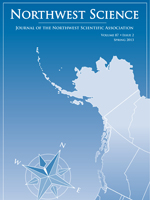Lamprey populations are in decline worldwide and the status of Pacific lamprey (Entosphenus tridentatus) is a topic of current interest. They and other lamprey species cycle nutrients and serve as prey in riverine ecosystems. To determine the current distribution of Pacific lamprey in major watersheds flowing into Puget Sound, Washington, we sampled lamprey captured during salmonid smolt monitoring that occurred from late winter to mid-summer. We found Pacific lamprey in 12 of 18 watersheds and they were most common in southern Puget Sound watersheds and in watersheds draining western Puget Sound (Hood Canal). Two additional species, western brook lamprey (Lampetra richardsoni) and river lamprey (L. ayresii) were more common in eastern Puget Sound watersheds. Few Pacific lamprey macrophthalmia were found, suggesting that the majority of juveniles migrated seaward during other time periods. In addition, “dwarf” adult Pacific lamprey (< 300 mm) were observed in several watersheds and may represent an alternate life history for some Puget Sound populations. Based on genetic data, the use of visual techniques to identify lamprey ammocoetes as Entosphenus or Lampetra was successful for 97% (34 of 35) of the samples we evaluated.
How to translate text using browser tools
1 May 2013
Distribution of Pacific Lamprey Entosphenus tridentatus in Watersheds of Puget Sound Based on Smolt Monitoring Data
Michael C. Hayes,
Richard Hays,
Stephen P. Rubin,
Dorothy M. Chase,
Molly Hallock,
Carrie Cook-Tabor,
Christina W. Luzier,
Mary L. Moser
ACCESS THE FULL ARTICLE

Northwest Science
Vol. 87 • No. 2
May 2013
Vol. 87 • No. 2
May 2013
ammocoete
dwarf-adult
identification
Lampetra
trap




